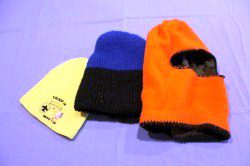by Leon Pantenburg
 |
| Check out this light! |
Balding, middle-aged men like me develop a real affection for hats that work well. I always wear some sort of head covering outdoors, and generally it will be some sort of broad-brimmed type.
But I also carry a stocking cap in my survival gear. A stocking hat, by way of (my) definition, is a loose knit, form-fitting cap, made of natural or synthetic fibers. The proper stocking hat can handle two vastly different scenarios.
Check out the video below!
Heat:
Mississippi has got to be one of the most hot, humid places anywhere during the summer months. At least it is, when you're wearing a wool uniform.
One summer, I was a Volunteer in the Park at Vicksburg National Military Park. I dressed in authentic Civil War clothing, and was part of a cannon crew that fired a 12-pound Napoleon for tourists. Also, as a Vicksburg Post staff reporter, I was drafted and "embedded" into a Confederate infantry unit at a couple of local re-enactments. (I protested vigorously, in the tradition of all conscripts, and pointed out the perfidy of the southern cause. At one point, I refused to stand and sing "Dixie" along with the other re-enactors. For this transgression, I was tied to a cannon in front of the Old Court House Museum as an example to other malcontents.)
At one of these living history events, I noticed a soldier wearing a stocking cap, drilling in the hot Mississippi sun. He claimed it kept him cool.
"It's cotton, and hand-knit by my sister," he told me. "I soak it in water before we hit the field, and the evaporation keeps me cool."
For improved sun protection, he sometimes wore a broad-brimmed straw planter's hat over the wet cap. The stocking cap provided insulation from the tropical sun and a source of water for evaporation. The straw hat shaded his head, face and neck. All his modern sun protection needs were taken care of very effectively by old-time technology.
This is a technique that can be adapted to your desert or hot weather hiking with a cotton stocking cap. The cap will be warm at night until it gets wet. In the daytime, soak it in water to help cool your head. This cap (unless it's a beanie) can also be pulled down over your eyes, ears, nose and neck for sun protection. A cotton bandana can also be put into service in a similar manner.
Cold: People think of thick, wool caps when they think of winter wear. I do.
One of my favorite hunting caps is a reversible camouflage/blaze orange synthetic ski-mask. I seldom pull the cap down over my face, but I know the option is there. When big game hunting, I wear the orange side out. When after waterfowl, the camo is used. In those instances, the face covering may be used to help hide my face.
A stocking cap is great to wear for stalking through deep woods, or when there is a lot of bush to go through.
 |
| I prefer a broad-brimmed wood hat for most of my outdoors wear, but also carry a stocking hat as a backup. |
Despite the versatility of this head covering, there are a few things to consider before buying one.
- Material: Don't buy a cotton cap for cold weather or a wool one for heat. The material of the cap will help determine when it should be used, and you don't want to get them mixed up. Wool stays warm when wet, which makes it a bad choice for dealing with the heat.
- Weave: A tight-knit hat will tend to be warm, and a loose construction will allow heat to dissipate quicker. Don't get a loose weave cap for warmth.
- Size: A beanie is typically not large enough to cover your face and nose if needed. Conversely, a large hat may be bulky and too hot.








